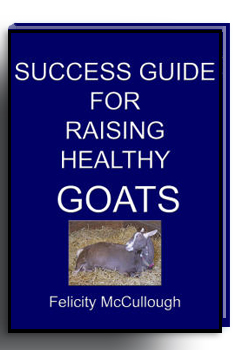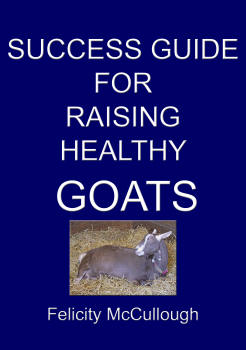Blog about Goats
Cheese Making Goat
Christmas Goats
Cooking Goat
Diseases of Goats
Goat Basics
Goat Books
Goat Fun
Goat Giving Birth Video
Goats Home
Goat Humour
Goat Island
Goat Knowledge
Goat Links
Goat Lotions
Goat Poetry
Goat Soap
Goat Songs
Goat Stories
Goat Transgenics
Goat Viruses
How to Raise Goats
India Goat Farming
Milking Goats
Nigerian Dwarf Goat
Nimbkar Boar Goat
Reproduction
Software Goat Recording
Spider Goats
Videos Goats
Weighing Goats
Goats - The Basics
Goats and gardens do not mix well and goats always want to eat what’s on the other side of the fence. If you have fruit bushes they will love to eat the berries. If you have overgrowth of brambles etc, goats are ideal to keep the growth down. Goats are pack animals, agile and sure-footed. Each goat needs between one and two acres for grazing. Sturdy four-foot high fencing is essential to contain them. Find out more.
Goats – What They Are Called
Male goats are referred to as a 'Buck' or 'Billy' goat. A male goat when castrated or neutered is called a 'Whether'. A female goat is known as 'Doe' or a 'Nanny' goat and its offspring, up to the age of one, is called a 'Kid'. Goats live in a herd and are collectively referred to as 'Caprine'. A cross-bred goat would be called a' Brush' goat.
Goats – Why they are kept
Goats can be kept for their meat, hair fibre, and dairy, or as a pet. They need fresh water, good quality hay and constant supplies when vegetation is scarce because of drought. Mineral and or salt lick blocks aids overall health.
Goats - Hair Usages
Most notably is cashmere that has become fashionable recently as well as Angora, and Mohair to make articles of clothing. The Cashmere goat is white and the Nigora breed of goat is also suitable for hair usage. Goats can be sheared twice a year and as they age the hair thickens, making it less valuable.
Goats – Breeds for Meat
Boer, Spanish, and Kiko goats are ideal for meat. Meat from a an adult is called chevon and from a young animal cabrito. It is widely eaten especially in the Middle East, India, and Pakistan and is becoming more popular in Mexico and the United States. In Europe it is considered a delicacy. Demand is rising with many countries having to import goat's meat. Goat's meat has a lower fat content than beef or lamb.
Goats - Milking
Dairy breeds are Alpine, Nubian, La Mancha, Nigerian Dwarf, Toggenburg and Oberhasli. The milk can be made in to cheese for which you would need a licence to sell, as well as products such as silky soap and smooth skin lotion. Their skins can be used for clothing, housing and can hold liquids.
A suitably well ventilated milking structure is essential, to minimise contamination and ensure hygiene, as well as a rigorous cleaning routines to prevent bacterial infestations and compliance with regulatory agencies. Cooled milk should have no foam on the surface and strained into a clean receptacle. Records need to be accurately maintained. Goat milk is suitable for making cheese, butter, ice cream and yoghurt and the resulting products are usually whiter, smoother and creamier. Goats milk has low lactose content, making it easily digestible especially for the young and elderly reducing the chance of intolerance to milk.
Goats – Keeping them as Pets
The Australian Miniature, the Nigerian goat and the Pygmy are breeds to consider when you are looking for a pet and can be great companions.
Goats - Housing
It is essential to provide suitable housing for your goats to provide shelter and protection from predators. Here you can deliver their feed through a head funnel, so they are occupied whilst you are milking them. This can also facilitate administering medicines and carrying out other maintenance tasks. Keeping goats in a residential area will need compliance with local laws. Goats are used to open spaces for grazing and traditionally are raised on farms, with space, enough habitat and well ventilated shelter.
Goats - Manure
The droppings from goats are similar to a berry's shape. When these pellets are clean they are odourless and can be used immediately as manure, as they dissolve slowly over time.
Goats - Worming
Garlic can be used as a natural wormer.
Goats - Hooves
Their hooves need regular trimming to keep them in good order.
Goats - Domestication
Goat is the 1st domesticated animal in the ancient age and has been considered to be the Poor Man's Cow. Goat's meat is lean & has low fat and the demand for goat's meat is increasing, with rising prices. Goats live for around 15 years and are productive for about seven years. Goats usually give birth to twins & triplets.
Goats - Species
Goats are herbivores and there are nine different species of goat. Goat is the common name under the genus Capra. Wild goats have horns as the domesticated goats have their horns removed.
Goats - Feed
Goats are ruminant animals that chew the cud. Pasture is the cheapest source of feed and this can be supplemented to ensure the goat gets the proper nutrition and nutrients. In mountainous, arid and semi-tropical regions, goats can thrive on scarce grass, a brush environment where cattle would not be able to survive. Goats will eat weeds and other weed-like plants that helps to improve the pasture for other livestock and cows.
Goats - Horns
Horns are thought to be connected to fertility and breeds that are hornless, known as polled, and are favoured less than breeds with horns, which are removed early in the goat's life.
Goats - Breeding
Does estrus period can last for at least twenty one days and this is commonly referred to as being 'in heat'. A nanny or doe goat gestation period is between 145 to 155 days. And they can give birth to between 1 and 6 kids.
The bucks need nutrients for semen production and growth and it is essential that disease and parasite control is effective to have the buck in optimum condition for breeding. Does must also be in good physical condition and over-eating needs to be monitored.
After forty-two days, the embryo enters the stage of being a foetus. For the last two months of pregnancy the doe will show a rounded belly and when near to giving birth the labia and the vulva become swollen and the tail ligaments begin to open up in preparation for the birth.
Mother and kid should be kept together for the first few days in a stall to ensure access to milk, facilitate bonding and protection from the rest of the herd. The kids need to be separated from the mother nanny goat after about three months and the sexes kept apart.
Goats - Latin Name
For the domestic goat it is Capra hircus. Capra being the genus name, and hircus being the species name. To refer to goats you would refer to them as being Caprine. Capra aegagrus hircus is a subspecies of goat domesticated from the wild goat of southwest Asia and Eastern Europe
Goat- Herder
A goat herder is a person who tends and drives a flock of goats and can also be called a goatherd, drover and herdsman.
We hope you found this information about goats and information on goats useful.

American Dairy Goat Association
American Goat Society
Dairy Goat Society of Australia
DEFRA UK
National Pygmy Goat Association
Pygmy Goat Club
Welfare of Goats During Transport
Keywords: Goats, Basics, Goat, gardens, eat, fence, fruit bushes, berries. Brambles, pack animals, agile, sure-footed, two acres for grazing, sturdy, four-foot high, fencing, Male goats, 'Buck', 'Billy', castrated, neutered, 'Whether', female goat, 'Doe', 'Nanny', 'Kid', herd, 'Caprine'. A cross-bred goat, ' Brush' goat, kept, meat, hair fibre, dairy, pet, fresh water, good quality hay, constant supplies, vegetation is scarce, drought, Mineral, salt-lick blocks, aids, health, Hair, Usages, cashmere, fashionable, Angora, Mohair, clothing, White Cashmere goat, Nigora, breed of goat, hair usage. Goats sheared, twice-a-year, age, hair thickens, valuable, Breeds for Meat, Boer, Spanish, Kiko, ideal for meat, Meat, adult, chevon, young, cabrito, eaten, Middle East, India, Pakistan, popular, Mexico, United States, Europe, delicacy, Demand, rising, countries, import goat's meat, Goat meat, lower fat content, Milking, Dairy breeds, Alpine, Nubian, La Mancha, Nigerian Dwarf, Toggenburg, Oberhasli, cheese, licence to sell, products, silky soap, smooth skin lotion, clothing, housing, hold liquids, ventilated milking structure, contamination, hygiene, cleaning routines, bacterial infestations, compliance, regulatory agencies, Cooled goat milk, foam, surface, strained, clean receptacle, Records, accurately, maintained, Goat milk, making cheese, butter, ice cream, yoghurt, products, whiter, smoother, creamier, low lactose content, digestible, young, elderly, intolerance to milk, Pets, Australian Miniature, Nigerian goat, Pygmy, breeds, companions, Housing shelter, protection, predators, feed, head funnel, milking them, administering medicines, maintenance tasks, Keeping goats, residential area, compliance, local laws, open spaces, grazing, raised farms, space, habitat, ventilated, shelter, Manure, droppings, berry shape, pellets, clean, odourless, used, manure dissolve, slowly, over time, Worming, Garlic, natural, wormer, Hooves, trimming, Domestication, domesticated animal, ancient, Poor Man's Cow, Goat's meat, lean low fat, demand, increasing, rising, prices. Goats live, 15 years, productive for about seven years, Goats, birth, twins, triplets, Species, herbivores, nine different species of goat, Goat, common name, genus, Capra, Wild goats, horns, domesticated goats, horns removed, Feed, ruminant animals, chew the cud, Pasture, cheapest source of feed, supplemented, proper nutrition, nutrients, mountainous, arid, semi-tropical regions, thrive, scarce grass, a brush environment, eat weeds, weed-like plants, improve the pasture, livestock, Horns, connected, fertility, breeds that are hornless, polled, favoured less, breeds with horns, removed early in the goat's life, Breeding, Does estrus period, twenty one days, 'in heat', nanny, doe goat, gestation, period, 145 to 155 days, give birth to between 1 and 6 kids, bucks, nutrients, semen production, growth, disease and parasite control, effective, buck in optimum condition, breeding, Does good physical condition, over-eating, monitored, forty-two days, embryo, stage, foetus, last two months, pregnancy rounded belly, labia and the vulva become swollen, tail ligaments, open up, preparation, birth, Mother and kid, kept together, stall, access to milk, facilitate bonding, protection, from herd, kids, separated, mother nanny goat, three months, kept apart, domestic goat, Capra hircus, genus name, species name, Caprine. Capra aegagrus hircus, subspecies, goat domesticated, wild goat of southwest Asia, Eastern Europe, Herder, tends, drives, flock of goats, called, goatherd, drover, herdsman.

